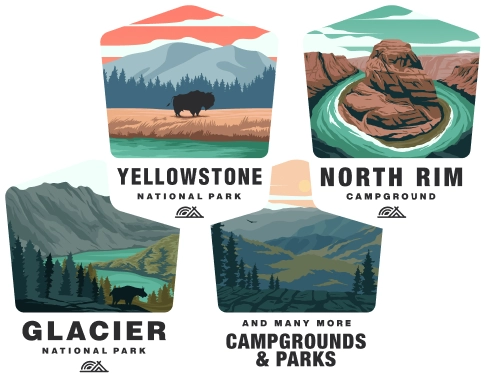Camping at Gifford Pinchot National Forest
General Overview
Gifford Pinchot National Forest is a massive national forest located in southern Washington. Named after the first Chief of the United States Forest Service, Gifford Pinchot, it spans 1.32 million acres and includes the Mount St. Helens National Volcanic Monument. It offers a diverse range of ecosystems from lush old-growth forests to active volcanic landscapes.
Camping Options
Dispersed Camping:
- Dispersed camping means camping outside of a designated campground.
- It's typically free and is allowed in many parts of the forest.
- Campers must follow "Leave No Trace" principles and pack out all trash.
Developed Campgrounds:
- These are designated areas that may have amenities such as picnic tables, fire pits, restrooms, and even potable water.
- Fees are generally required and can vary depending on the site and the amenities offered.
- Reservations may be necessary, especially during peak season.
Backcountry Camping:
- For those looking for a remote experience, backcountry camping is allowed.
- It is important to be prepared for wilderness conditions and to register for a backcountry permit if required.
Group Campgrounds:
- Certain areas within the forest are equipped to handle large groups.
- These sites have more space and additional facilities to accommodate group activities.
Cabin Rentals:
- A few rustic cabins are available for rent in the forest for those looking for a more comfortable experience.
- These can be booked through the Forest Service or online reservation systems.
Regulations and Safety
- Campfire Restriction: Depending on the time of the year and fire danger level, campfires may be restricted. Always check the latest fire regulations before lighting a fire.
- Wildlife Precautions: This region is home to bears and other wildlife. Proper food storage and disposal are required to avoid attracting animals to camp sites.
- Leave No Trace: As mentioned earlier, visitors are responsible for preserving the natural state of the forest. Always pack out what you pack in, and try to minimize your impact.
- Permits: Certain areas may require a pass or permit for entry or overnight stays. This can include the Northwest Forest Pass or a specific Mount St. Helens climbing permit.
Amenities and Supplies
What You’ll Find:
- Amenities vary by campground, with some offering full services including showers and electric hookups and others offering only the most basic facilities.
- Visitor centers can provide information, educational displays, and sometimes basic supplies.
What to Bring:
- Adequate clothing for changing weather conditions.
- Navigation tools such as a map and compass or GPS.
- Food and water, plus a way to treat water if you'll be relying on natural sources.
- Emergency and first aid equipment.
- Tools and supplies for making camp, such as a tent, sleeping bag, and cooking gear.
Activities
Hiking:
- There are an abundance of trails that range from easy to rugged. These include part of the famous Pacific Crest Trail.
Water Activities:
- Lakes and rivers offer opportunities for boating, fishing, and swimming.
Winter Sports:
- In the winter, certain areas offer opportunities for snowshoeing, skiing, and snowboarding.
Wildlife Viewing:
- The forest supports diverse wildlife and offers excellent opportunities for bird watching and seeing animals in their natural habitat.
Travel Tips
- Always inform someone about your travel itinerary and expected return.
- Check the weather forecast and be prepared for sudden changes in weather.
- Ensure your vehicle is in good condition; remote areas can be challenging to access and may not have cell service.
- Research specific campground or trail conditions and closures before your trip.
Conclusion
Gifford Pinchot National Forest provides a multitude of camping and outdoor recreation opportunities. Whether you're looking for a developed campsite or a backcountry adventure, you'll find it here. Remember to follow all rules and regulations to ensure the forest remains pristine for future visitors. Always be prepared for wilderness conditions and respect the diverse ecosystems you're visiting.
